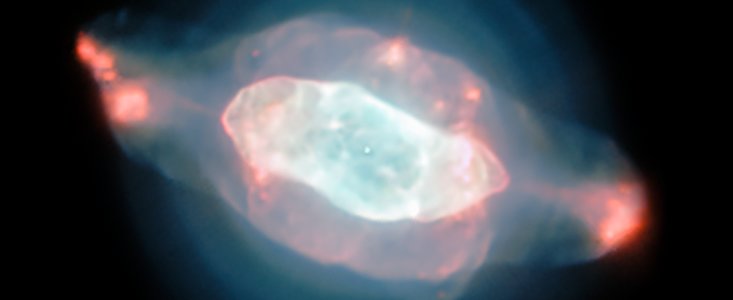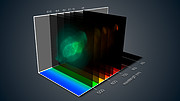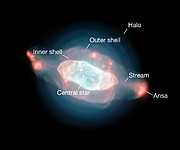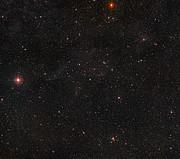Lehdistötiedote
Saturnus-sumun oudot rakenteet
27. syyskuuta 2017
Näyttävä planetaarinen sumu NGC 7009 eli Saturnus-sumu ilmaantuu pimeydestä kuin sarja oudonmuotoisia kuplia, jotka loistavat upeissa vaaleanpunaisen ja sinisen sävyissä. Tämä värikäs kuva otettiin ESO:n VLT-teleskoopin tehokkaalla MUSE-havaintolaitteella osana tutkimusta, joka kartoitti planetaarisen sumun sisäistä tomua ensimmäistä kertaa. Muun muassa kuoria, halon ja kiehtovia aaltomaisia rakenteita käsittäviä tomun runsaita, monimutkaisia rakenteita paljastava kartta auttaa tähtitieteilijöitä ymmärtämään kuinka planetaariset sumut kehittävät oudot muotonsa ja symmetriansa.
Saturnus-sumu sijaitsee noin 5000 valovuoden etäisyydellä Vesimiehen tähdistössä (Aquarius). Sen nimi tulee sen oudosta muodosta, joka muistuttaa kaikkien lempirengasplaneettaa sivulta nähtynä.
Tosiasiassa planetaarisilla sumuilla ei kuitenkaan ole mitään tekemistä planeettojen kanssa. Saturnus-sumu oli alunperin pienimassainen tähti, joka laajeni punaiseksi jättiläiseksi elämänsä lopulla ja alkoi vuotaa avaruuteen uloimpia kaasukerroksiaan. Voimakkaat tähtituulet puhalsivat tämän materian ulos ja jäljelle jääneen kuuman tähtiytimen ultraviolettisäteily nosti sen energiatasot niin, että muodostui tähteä ympäröivä tomun ja kirkasvärisen kuuman kaasun sumu. Saturnus-sumun ytimessä sijaitsee tässä kuvassa näkyvä tuhoon tuomittu tähti, joka on muuttumassa valkoiseksi kääpiöksi [1].
Ymmärtääkseen paremmin kuinka planetaariset sumut muovautuvat tällaisiin outoihin muotoihin ESO:n Jeremy Walshin johtama kansainvälinen tähtitieteilijäryhmä käytti MUSE-havaintolaitetta (Multi Unit Spectroscopic Explorer) kurkistaakseen Saturnus-sumun tomuhuntujen sisäpuolelle. MUSE on yhteen neljästä ESO:n Paranalin observatoriolla Chilessä sijaitsevan VLT-teleskoopin yksikköteleskoopista asennettu havaintolaite. Se on niin tehokas, koska se ei vain muodosta kuvaa vaan myös kerää tietoa kuvan jokaisen pisteen valon spektristä eli värijakaumasta.
Tutkimusryhmä käytti MUSE:a tuottaakseen ensimmäisen yksityiskohtaisen optisen kartan planetaarisen sumun kautta jakautuneesta kaasusta ja tomusta [2]. Tuloksena on Saturnus-sumusta saatu kuva, joka paljastaa monia hienoja rakenteita, mukaanlukien elliptisen sisäkuoren, ulkokuoren ja halon. Se näyttää myös kaksi aikaisemmin kuvattua virtausta, jotka ulottuvat sumun pitkän akselin molemmista päistä ja päättyvät kirkkaisiin kahvamaisiin rakenteisiin.
Mielenkiintoista kyllä, tutkimusryhmä löysi tomusta myös aaltomaisen rakenteen, jota ei vielä täysin ymmärretä. Tomu om jakaantunut kautta koko sumun, mutta tomun määrässä on merkittävä vähenemä sisemmän kuoren reunalla, missä näyttää siltä, että se tuhoutuu. Tähän tuhoutumiseen on olemassa useita mahdollisia mekanismeja. Sisempi kuori on pohjimmiltaan laajeneva shokkiaalto, joten se saattaa iskeytyä tomuhiukkasiin tuhoten ne, tai tuottaen ylimääräisen kuumenemisilmiön, joka haihduttaa tomua.
Kaasun ja tomun rakenteiden kartoittaminen planetaaristen sumujen sisällä auttaa ymmärtämään niiden roolia pienimassaisten tähtien elämässä ja kuolemassa sekä auttaa myös tähtitieteilijöitä ymmärtämään kuinka planetaariset sumut saavat oudot ja monimutkaiset muotonsa.
MUSE:n mahdollisuudet ulottuvat kauas planetaaristen sumujen ulkopuolelle. Tämä herkkä havaintolaite kykenee myös tutkimaan tähtien ja galaksien muodostumista varhaisessa maailmankaikkeudessa sekä kartoittamaan pimeän aineen jakaumaa lähimaailmankaikkeuden galaksijoukoissa. MUSE on myös muodostanut ensimmäisen 3D-kartan Luomisen pilareista Kotkasumussa (eso1518) ja kuvannut näyttävän kosmisen törmäyksen läheisessä galaksissa (eso1437).
Lisähuomiot
[1] Planetaariset sumut ovat yleensä lyhytikäisiä. Saturnus-sumu kestää vain joitakin kymmeniä tuhansia vuosia ennen kuin se laajenee ja viilenee niin paljon, että se muuttuu meille näkymättömäksi. Keskustan tähti jatkaa himmenemistä sen muuttuessa kuumaksi valkoiseksi kääpiöksi.
[2] NASA:n ja ESA:n Hubble-avaruusteleskooppi on aikaisemmin tuottanut näyttävän kuvan Saturnus-sumusta, mutta — toisin kuin MUSE — se ei voi paljastaa koko sumun jokaisen pisteen spektriä.
Lisätietoa
ESO on Euroopan johtava hallitustenvälinen tähtitieteen organisaatio ja maailman tieteellisesti tuotteliain tähtitieteellinen observatorio. ESO:lla on 16 jäsenmaata: Alankomaat, Belgia, Brasilia, Espanja, Iso-Britannia, Italia, Itävalta, Portugali, Puola, Ranska, Ruotsi, Saksa, Suomi, Sveitsi, Tanska ja Tšekin tasavalta. ESO toteuttaa kunnianhimoista ohjelmaa, joka keskittyy tehokkaiden maanpäällisten havaintovälineiden suunnitteluun, rakentamiseen ja käyttöön. Välineiden avulla tähtitieteilijät voivat tehdä merkittäviä tieteellisiä löytöjä. ESO:lla on myös johtava asema tähtitieteen tutkimuksen kansainvälisen yhteistyön edistämisessä ja organisoinnissa. ESO:lla on Chilessä kolme ainutlaatuista huippuluokan observatoriota: La Silla, Paranal ja Chajnantor. ESO:lla on Paranalilla Very Large Telescope (VLT), maailman kehittynein näkyvää valoa havainnoiva tähtitieteellinen observatorio, ja kaksi kartoitusteleskooppia. VISTA toimii infrapuna-alueella ja on maailman suurin kartoitusteleskooppi. VLT Survey Telescope on suurin vartavasten taivaan näkyvän valon kartoitukseen suunniteltu teleskooppi. ESO on yksi maailman suurimman tähtitieteellisen projektin, ALMA-teleskoopin pääyhteistyökumppaneista. Lähellä Paranalia sijaitsevalla Cerro Armazonesilla ESO rakentaa 39-metrin kokoista E-ELT -teleskooppia (European Extremely Large Telescope), josta tulee “maailman suurin tähtitaivasta havainnoiva silmä”.
Linkit
Yhteystiedot
Jeremy Walsh
ESO
Garching bei München, Germany
Sähköposti: jwalsh@eso.org
Richard Hook
ESO Public Information Officer
Garching bei München, Germany
Puh.: +49 89 3200 6655
Matkapuhelin: +49 151 1537 3591
Sähköposti: rhook@eso.org
Pasi Nurmi (Lehdistön yhteyshenkilö Suomi)
ESO Science Outreach Network
ja University of Turku
Turku, Finland
Puh.: +358 29 4504 358
Sähköposti: eson-finland@eso.org
Tiedotteesta
| Tiedote nr.: | eso1731fi |
| Nimi: | NGC 7009, Saturn Nebula |
| Tyyppi: | Milky Way : Nebula : Type : Planetary |
| Facility: | Very Large Telescope |
| Instruments: | MUSE |
Our use of Cookies
We use cookies that are essential for accessing our websites and using our services. We also use cookies to analyse, measure and improve our websites’ performance, to enable content sharing via social media and to display media content hosted on third-party platforms.
ESO Cookies Policy
The European Organisation for Astronomical Research in the Southern Hemisphere (ESO) is the pre-eminent intergovernmental science and technology organisation in astronomy. It carries out an ambitious programme focused on the design, construction and operation of powerful ground-based observing facilities for astronomy.
This Cookies Policy is intended to provide clarity by outlining the cookies used on the ESO public websites, their functions, the options you have for controlling them, and the ways you can contact us for additional details.
What are cookies?
Cookies are small pieces of data stored on your device by websites you visit. They serve various purposes, such as remembering login credentials and preferences and enhance your browsing experience.
Categories of cookies we use
Essential cookies (always active): These cookies are strictly necessary for the proper functioning of our website. Without these cookies, the website cannot operate correctly, and certain services, such as logging in or accessing secure areas, may not be available; because they are essential for the website’s operation, they cannot be disabled.
Functional Cookies: These cookies enhance your browsing experience by enabling additional features and personalization, such as remembering your preferences and settings. While not strictly necessary for the website to function, they improve usability and convenience; these cookies are only placed if you provide your consent.
Analytics cookies: These cookies collect information about how visitors interact with our website, such as which pages are visited most often and how users navigate the site. This data helps us improve website performance, optimize content, and enhance the user experience; these cookies are only placed if you provide your consent. We use the following analytics cookies.
Matomo Cookies:
This website uses Matomo (formerly Piwik), an open source software which enables the statistical analysis of website visits. Matomo uses cookies (text files) which are saved on your computer and which allow us to analyze how you use our website. The website user information generated by the cookies will only be saved on the servers of our IT Department. We use this information to analyze www.eso.org visits and to prepare reports on website activities. These data will not be disclosed to third parties.
On behalf of ESO, Matomo will use this information for the purpose of evaluating your use of the website, compiling reports on website activity and providing other services relating to website activity and internet usage.
Matomo cookies settings:
Additional Third-party cookies on ESO websites: some of our pages display content from external providers, e.g. YouTube.
Such third-party services are outside of ESO control and may, at any time, change their terms of service, use of cookies, etc.
YouTube: Some videos on the ESO website are embedded from ESO’s official YouTube channel. We have enabled YouTube’s privacy-enhanced mode, meaning that no cookies are set unless the user actively clicks on the video to play it. Additionally, in this mode, YouTube does not store any personally identifiable cookie data for embedded video playbacks. For more details, please refer to YouTube’s embedding videos information page.
Cookies can also be classified based on the following elements.
Regarding the domain, there are:
- First-party cookies, set by the website you are currently visiting. They are stored by the same domain that you are browsing and are used to enhance your experience on that site;
- Third-party cookies, set by a domain other than the one you are currently visiting.
As for their duration, cookies can be:
- Browser-session cookies, which are deleted when the user closes the browser;
- Stored cookies, which stay on the user's device for a predetermined period of time.
How to manage cookies
Cookie settings: You can modify your cookie choices for the ESO webpages at any time by clicking on the link Cookie settings at the bottom of any page.
In your browser: If you wish to delete cookies or instruct your browser to delete or block cookies by default, please visit the help pages of your browser:
Please be aware that if you delete or decline cookies, certain functionalities of our website may be not be available and your browsing experience may be affected.
You can set most browsers to prevent any cookies being placed on your device, but you may then have to manually adjust some preferences every time you visit a site/page. And some services and functionalities may not work properly at all (e.g. profile logging-in, shop check out).
Updates to the ESO Cookies Policy
The ESO Cookies Policy may be subject to future updates, which will be made available on this page.
Additional information
For any queries related to cookies, please contact: pdprATesoDOTorg.
As ESO public webpages are managed by our Department of Communication, your questions will be dealt with the support of the said Department.








